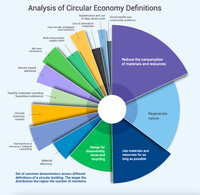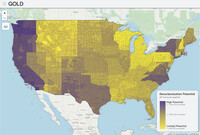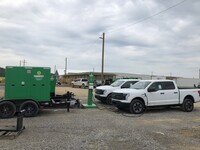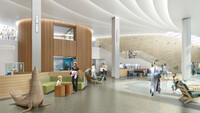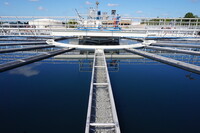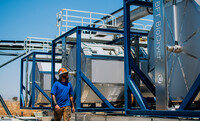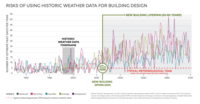News Analysis
Global heating is already making today’s children more vulnerable, a new EPA report reveals. Adaptation measures are needed to protect them.
Replete with heart-wrenching photos of tiny children sucking on inhalers, enduring insect welts, and watching flood waters rise, a new report from the U.S. Environmental Protection Agency (EPA) details the grueling impacts climate change is having and is likely to have on America’s kids. Socially vulnerable youth will be disproportionately... Read more
News Brief
Upending the global economy to make it circular instead of linear sounds daunting. A new resource demonstrates how to become “circular ready.”
Here’s the problem. The economy we’re locked into is linear: to make products, we exploit fellow human beings, deplete natural resources, threaten biodiversity, and choke our atmosphere. Then we toss those products into landfills the moment we consider them to be broken or used up. What a waste.
Here’... Read more
News Brief
Galvanize Climate Solutions commissioned a custom version of EHDD’s software to locate real estate with financial and sustainability potential.
Investors Katie Hall and Tom Steyer founded Galvanize Climate Solutions in 2021 with one goal: “to accelerate the adoption of clean technology and increase the rate of decarbonization.” The company’s new real estate arm aims to do that by acquiring and renovating existing buildings. And to help it find those buildings, Galvanize commissioned a... Read more
Spotlight Report
People interested in reducing the embodied carbon of buildings are familiar with weighing the impact of different materials, like mass timber or low-carbon concrete. Low-carbon construction has not been on many people’s radar—but it probably should be.
Findings from construction companies that are tracking greenhouse... Read more
News Analysis
ASHRAE 228 aims to replace the Department of Energy’s “gold standard” definition of net-zero energy—and it adds carbon to the mix.
Just when you thought you were safe, another big, bold net-zero standard has entered the house. But ASHRAE 228, Standard Method of Evaluating Zero Net Energy and Zero Net Carbon Building Performance, isn’t here to disrupt things. Instead, like any good standard, it just wants to bring us all together in a group bear hug—an embrace with the... Read more
Feature
Some researchers say construction emissions could account for as much as 30% of a project’s embodied carbon. What can be done about it?
Nadav Malin contributed reporting.
Practitioners interested in reducing the embodied carbon of buildings are likely familiar with weighing the impact of different materials, like mass timber or low-carbon concrete. Low-carbon construction, however, has not been on many people’s radar.
“I don't think people up until now even... Read more
News Brief
An Earth Day executive order looks to protect communities burdened by pollution. The details hint at the scale of change that’s needed.
To fulfill our Nation’s promises of justice, liberty, and equality, every person must have clean air to breathe; clean water to drink; safe and healthy foods to eat; and an environment that is healthy, sustainable, climate-resilient, and free from harmful pollution and chemical exposure.
– President Joe Biden, Executive Order 14096 on... Read more
Op-Ed
Robin Guenther advanced new standards for hospitals that were adopted by the larger green building community and integrated into leading rating systems.
We acknowledge with mournful hearts the death of Robin Guenther, FAIA, a leading expert in evidence-based healthcare design and an early, vocal critic of questionable chemistries that remain all too common in building materials. Robin died of ovarian cancer on May 6, 2023, according to a New York Times obituary.
Robin had long decried... Read more
Product Guide
Electrical and communication cables typically have an insulation layer around the wire and are coated with jacket materials that protect them from damage and improve safety in various applications. There are cables rated for use in standard applications (such as risers) and in plenums, where added flame resistance is necessary. As a result,... Read more
News Analysis
In a new strategy, the EEOC plans to tackle workplace discrimination in industries lacking in diversity, including construction.
The construction industry has a diversity and discrimination problem, and in January, the U.S. Equal Employment Opportunity Commission (EEOC) took formal notice. In its recently proposed Strategic Enforcement Plan (SEP), effective from 2023 through 2027, the EEOC explains that it will prioritize discrimination cases in certain industries,... Read more
News Brief
A proposed rule would regulate six PFAS “forever chemicals” in drinking water. The agency faces a backlash over the cost of compliance.
The U.S. Environmental Protection Agency (EPA) has proposed a new rule limiting per- and poly-fluoroalkyl substances (PFAS “forever chemicals”) in drinking water.
PFAS—a class of chemicals used to repel dirt and liquids from carpets and textiles and to make cookware “nonstick”—are ubiquitous in building materials and have been banned in... Read more
Product Review
Solid Carbon’s biochar admixture can create a carbon-negative concrete, with the help of other concrete additives and credit for avoided emissions.
The race to address climate change has had a profound impact on the concrete industry as it attempts to lower its historically high embodied carbon. Low-carbon concretes are now available for most applications. They are not a one-size-fits-all low-carbon solution, however, which makes the specification process more challenging... Read more
News Analysis
While governments continue to adopt “buy clean” procurement policies, a newer race is on to limit embodied carbon through codes. But the fate of the effort is uncertain.
The urgency of curbing embodied carbon, the greenhouse gas emissions associated with building materials, continues to escalate. Voluntary rating systems have been working away at the issue for more than a decade. More recently, states like California, several cities, and some U.S. agencies started adopting “buy clean” policies... Read more
News Brief
Urban Mining Industries’ Pozzotive glass pozzolan can replace portland cement in concrete and is now a Concrete Innovation Award winner.
Pozzotive glass pozzolan won a 2023 Innovative Product or Service award at the recent National Ready Mixed Concrete Association (NRMCA) conference in Las Vegas. As part of NRMCA’s Build With Strength sustainability initiative, the organization gives out awards for products that show a “commitment to improving the resilience,... Read more
News Brief
Architects want to design for future weather, but the data aren’t formatted with them in mind.
There is now more information available than ever about how our climate is likely to change. Why aren’t architects using those projections to design safer, more resilient buildings?
The University of Minnesota Climate Adaptation Partnership (MCAP) and HGA recently conducted a study to answer that... Read more
Product Guide
Interior paint can be a source of VOCs and other contaminants, and some may not be durable enough for intended applications. Interior paints have to balance low emissions and toxicity with durability and performance. If paint needs to be reapplied too often, it wastes resources and exposes workers and building occupants to additional VOCs.... Read more
Op-Ed
Three Millennials and ten members of Gen Z share scorching, optimistic, and skeptical thoughts about their future and the future of the planet.
When I was a kid in the ’80s, the constant threat of nuclear apocalypse kept my friends and me up at night. At the same time, the probability of full-scale thermonuclear warfare was small. So we kids put our trust in the adults in power and forgot about it most of the time. Anxious nights aside, we listened to Casey Kasem on... Read more
News Analysis
Even constrained urban sites offer biodiversity and equitable access to nature, and winners also include a city park, a nature center, and a tech campus with a public waterfront.
The Committee on the Environment (COTE) of the American Institute of Architects (AIA) has unveiled its annual top ten awards for high-performance projects. The projects feature cutting-edge accomplishments in all ten COTE design categories (which a few years ago were also promulgated as the AIA Framework for Design Excellence... Read more
Webcast
The integrative process holds great promise—identifying cost savings, improving building performance, and helping teams discover and implement unique solutions. Proponents also point to other benefits, including shorter project timelines and a more inclusive (and even joyful) work climate. Despite these enticements, this way of... Read more
Spotlight Report
There are few materials that are as ubiquitous as concrete—or that cause as much environmental consternation. Concrete is one of the construction industry’s largest carbon emitters, responsible for about 5% to 8% of the world’s anthropogenic greenhouse gas emissions, yet it is also one of the most important building materials, used in... Read more


